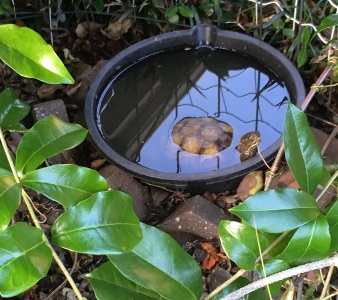 Box turtles really make wonderful pets. They live a long time (often they can outlive their families), they are pretty easy to care for, do well for families who travel, and are relatively low maintenance. Turtles do need an exotic pet vet for checkups and to address health issues that may pop up (usually do to nutrition). Box turtles do best outside during warmer temperatures (above 58 degrees) and they do NOT need a pond or water element because, even though they are called box TURTLES, they do not spend a lot of time in water and when they do, they prefer a shallow dipping pool.
Box turtles really make wonderful pets. They live a long time (often they can outlive their families), they are pretty easy to care for, do well for families who travel, and are relatively low maintenance. Turtles do need an exotic pet vet for checkups and to address health issues that may pop up (usually do to nutrition). Box turtles do best outside during warmer temperatures (above 58 degrees) and they do NOT need a pond or water element because, even though they are called box TURTLES, they do not spend a lot of time in water and when they do, they prefer a shallow dipping pool.
Ideally, you can create a turtle garden from the ground up rather than using something you already had in place.
Here’s whatya need:
- Chicken wire the size and shape of the ground area you are going to create your garden on.
- Shovel
- Dirt
- A large plant saucer or two (the bigger the better)
- a flat rock or two
- A shade provider like a Gardenia, a citrus tree, or a Camelia groomed into a small tree (no low hanging branches). This will protect your turtle(s) from birds and cats. Be sure the tree is large enough to cover the entire area of the pen.
- Monkey grass
- Bricks to edge
- Garden edging (Plastic or wire, just make sure it’s spaced close enough so your turtle can’t turn on her side and fit through). Make sure it is tall enough that she cannot climb it
- An over turned flower pot for each turtle, you can also get a proper turtle tunnel or hidey nook from a pet store, a hollow log, anything that provides a small shelter that other animals cannot get in or get them out of.
- A feeding dish
So here’s whatcha gonna do:
- Plant your tree or bush (with the bottom branches removed) in the middle of the enclosure.
- Dig your earth about a foot down across the entire enclosure and lay down your chicken wire.
- Lay bricks on top of the chicken wire along the edges, this creates a nice base so your turtles can safely dig but not escape.
- Place your garden edging just outside of the bricking on the undug ground
- Fill in the entire enclosure with dirt. Pack it down and add a top layer of looser dirt
- Sink your plant saucer (which is the turtle’s dipping pool) on one end
- Place the rock in the middle of the saucer
- Scatter other rocks (away from the sides), a flower pot, hollow log, and a ball or two in the garden (yes, some turtles do play with balls or other toys).
- Put your turtle in the pen and observe her. At first, observe her time in her pen. See where she goes, where she tries to escape. The more you understand her, the better you can secure her area. Different turtles try different escape routes. You can start leaving her out alone more and more as you both become secure in the safety of the set up.